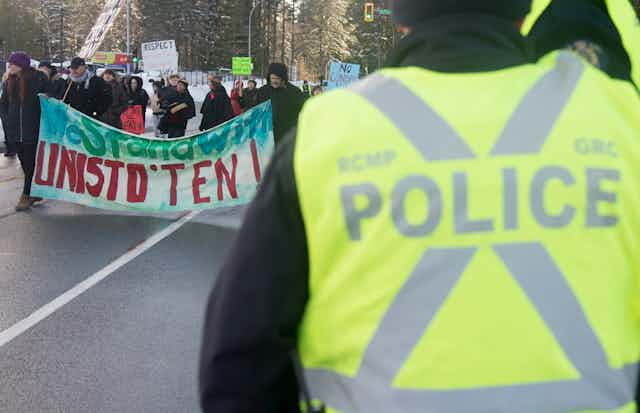Recent legal reforms in Alberta and Saskatchewan suggest both provinces could be gearing up for more violence against Indigenous Peoples, even as both commit to reconciliation.
Historically, Canadian state violence against Indigenous Peoples has included direct force and invoking laws to intimidate and dispossess. These provincial reforms expand police powers, introduce military-style weapons and sanction the increased use of force by private individuals. None consider treaty obligations.
Alberta targeting Indigenous protesters
Alberta’s Critical Infrastructure Defence Act came into effect on June 17 despite significant public opposition. It is now illegal to be in areas designated as “essential infrastructure” without a reason. Essential infrastructure is broadly defined. It even includes highways.
Violations of the act can result in fines of $1,000 to $10,000 for the first offence and up to $25,000 for subsequent offences. Jail terms extend up to six months. But the penalties are limitless, because every day permits a new infraction.
Introduced in the midst of Wet’suwet’en land defence and passed during the COVID-19 emergency, the Alberta act targets Indigenous people who protect the land, the environment, Indigenous women and Indigenous self-determination.
The legislation also introduces more opportunities for authorities to harass and intimidate Indigenous Peoples in their daily lives. Merely walking along a highway can violate the law. Indigenous Peoples sometimes walk along highway routes as they often have few safer options despite the dangers in doing so.
It remains to be seen if Alberta will, contrary to its treaty obligations, enforce the act on First Nations territories. The question was raised, but not answered, during the legislative debate.
Indigenous land defenders have been met with force on their land in other provinces. July 11 marked the 30th anniversary of Kanesatake. Québec police and eventually the Canadian military were sent in when Kanien’keha:ka (Mohawks) resisted the expansion of a golf course on unceded Mohawk territory.

With the support of British Columbia’s government, the RCMP also used force against Indigenous protesters on Wet’suwet’en land.
Prof. Heidi Kiiwetinepinesiik Stark from the University of Victoria explains how Canada was built on the criminalization of Indigenous peoples. The discursive depiction of Indigenous men as criminals allowed the state to suppress Indigenous resistance while deflecting from the state’s own colonial violence.
Alberta’s Critical Infrastructure Defence Act furthers Indigenous criminalization.
Militarizing Saskatchewan’s conservation officers
Provincial governments are also finding ways to employ more officers with more powers and more weapons.
In 2017, Saskatchewan gave conservation officers expanded investigative and arrest powers. The province’s Ministry of the Environment also purchased military-style semi-automatic weapons for conservation officers. The stated threat used to justify the purchase of these deadly weapons? Officers work in “remote” or “rural” areas and encounter “high-risk individuals.”
Indigenous leaders have raised concerns about arming conservation officers, particularly given the disproportionate policing and state violence directed at Indigenous communities. The courts and numerous inquiries reinforce these facts.
Even before they were armed, conservation officers played a key role in Indigenous dispossession.
As we explained in an earlier article, Saskatchewan conservation officers charged law professor Sylvia McAdam (Saysewahum) and her brother, Kurtis, with building a cabin on their ancestral family’s land in Treaty 6 territory. The land had been designated a provincial park. At trial, the responsible conservation officer testified that treaty obligations were not considered when the charge was laid.
Read more: Law professor put on trial for 'trespassing' on family's ancestral lands
Treaty 6 promises Nêhiyawak (Cree) the right to hunt in their traditional lands. As McAdam explains in Nationhood Interrupted, Nêhiyawak have never understood Treaty 6 to mean that they were ceding their land or resources.
Shortly before the case was dismissed, McAdam’s aunt Rose Morin disclosed to her that conservation officers had established checkpoints surrounding Big River First Nation. They wanted to search vehicles for an alleged hunting violation. The move was seen as a reminder to the community that Canada’s laws were stacked against them.
Fighting rural crime
Indigenous communities have also expressed concerns about laws that empower individuals to use violence in response to “rural crime.” There is fear that white farmers will feel empowered to use lethal force against Indigenous peoples in racially charged circumstances.
In 2018, Gerald Stanley was acquitted of second degree murder by an all-white jury in the killing of Colten Boushie, a 22-year-old Nêhiyaw man from the Red Pheasant First Nation. Boushie and his friends had driven onto Stanley’s farm looking for help with a flat tire. Claiming that his gun went off by accident, Stanley shot Boushie in the head at close range. In the wake of Stanley’s trial, some Saskatchewan farmers called for the right to use force against those they deemed to be intruders.

The case highlights the extent to which private property, trespassing and “the intruder narrative” have justified violence by private individuals against Indigenous Peoples.
Stanley’s acquittal was widely criticized as an example of the racist violence inflicted on Indigenous peoples by non–Indigenous people who have Canadian law on their side. The Crown made the controversial decision not to appeal.
Jury selections, the RCMP’s conduct, disregard for treaty obligations, bias against Indigenous people — all were the subject of much public debate and outcry.
None of these concerns have been squarely addressed.
Instead, Saskatchewan amended its Trespass to Property Act. It diluted the legal liability that might arise from the excessive use of force against an alleged trespasser. Alberta similarly amended its trespass legislation in December 2019.
Rural crime has also served as justification for other legislative changes. It was invoked to justify arming and extending police powers to Saskatchewan’s conservation officers. Alberta is considering the creation of a “voluntary civilian corps” to also fight rural crime.
Saskatchewan and Alberta claim commitment to reconciliation with Indigenous Peoples. Yet both have passed laws that fortify patterns of colonial violence against Indigenous communities and lands.
The militarization of law enforcement, expanded police powers and empowerment of civilian violence have long marked white colonial violence on Turtle Island. It appears that provincial governments are gearing up for more of the same.

